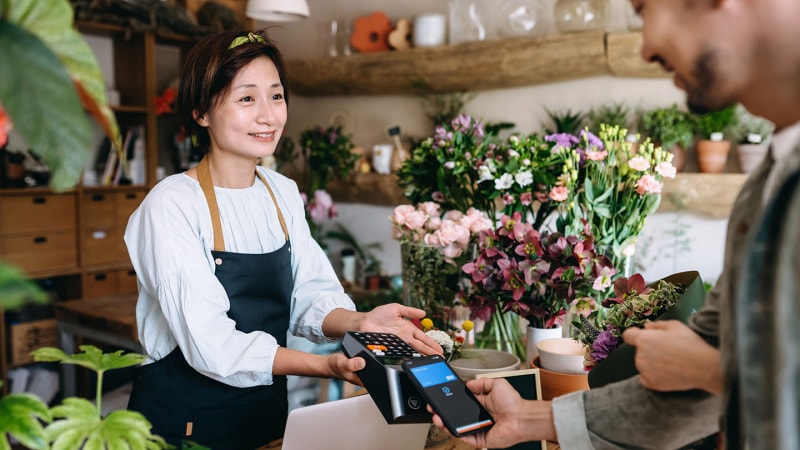A quick guide to digital payments

Quick insights
- Digital payments are payments made electronically for goods or services.
- Digital payments can be made via mobile apps, online bank transfers or contactless payment methods.
- When using digital payments, you’ll likely want to use cybersecurity best practices.
Tap, swipe or scan. There are many ways to make financial transactions without ever having to touch money. In recent years, digital payments have surpassed traditional payment methods. A 2023 Chase study found that 82% of respondents used digital payments at least once a month, and nearly half pay digitally once a week or more. Let’s take a closer look at digital payments—what they are and how do they work.
Understanding digital payments
Digital payments allow you to pay for goods or services without physical money ever being a part of the transaction. There has been a shift from traditional payment methods to digital options in recent years, with convenience and speed likely being key drivers of this shift. The COVID-19 pandemic also played a part in accelerating the adoption of electronic payment methods as paying for things electronically became a necessity in 2020.
The growth of e-commerce sites and the integration of digital payment methods into smartphones also has propelled the use of digital payments. Biometric payments, where authentication is based on physical characteristics, are more common as well thanks to fingerprint and face recognition becoming standard features on most new cell phones.
Types of digital payments
Digital payments can be classified in a few ways. They include:
- Mobile payments: Mobile payments are made through a mobile device, such as a smartphone or tablet, using apps or digital wallets.
- Online bank transfers: Online bank transfers are electronic transactions that move money from one bank account to another via the internet. They work by using the bank's online platform or mobile app to initiate the transfer, which can include options like ACH transfers, wire transfers and peer-to-peer payments.
- Contactless payments: Contactless payments are transactions made by tapping a credit card, smartphone or wearable device near a compatible point-of-sale terminal. They work by transmitting payment information wirelessly when the device is held close to the terminal.
Digital wallets explained
Digital wallets are applications that store payment information on a mobile device, allowing users to make payments electronically. Most mobile devices now come preloaded with digital wallets, giving rise to the popularity of Apple Pay, Google Wallet and Samsung Pay.
Digital wallets can store multiple types of payment information. In most digital wallets, you can upload:
- Personal credit and debit cards
- Business credit and debit cards
- Gift cards
- Concert tickets, movie tickets and theme park admissions
- Transit cards
- Airline boarding passes
- Your driver's license or state ID
- Insurance cards
Having a digital wallet provides a convenient way to make quick and secure transactions as well as store identification and tickets.
How digital payments work
Digital payments allow you to pay for goods and services without having to fetch your card or cash from your wallet. Most digital payments require these steps:
- Initiation: The consumer starts the transaction from an app, website or payment terminal in a store.
- Authentication: With most digital payment methods, you’ll need to confirm your identity. This can be done with passwords, pins, email addresses or other security measures.
- Authorization: The payment system contacts your bank to authorize the transaction and ensure you have sufficient funds.
- Processing: The final step when funds are transferred from your account to the merchant.
Most of these steps happen near instantly because digital payments can be processed quickly by most merchants and banks.
Security of digital payment methods
As the popularity of digital payments rises, so do security concerns. Digital payments are subject to data breaches and phishing attacks, so adopting cybersecurity best practices extends to the use of digital payments.
When using digital payments, you may want to:
- Use multi-factor authentication whenever possible.
- Create strong username and passwords.
- Verify that the transaction portal you’re using is secure.
- Monitor your online accounts for transactions that are unusual or you don’t recognize.
Many digital payments methods have built-in security measures like two-factor authentication and encryption.
Choosing the right digital payment method
The prevalence of digital payment methods means as a consumer, you have options when choosing to pay. When deciding on a digital payment, you may want to consider:
- Security: Ensure the digital payment method uses robust encryption and authentication measures to protect your financial information from fraud and unauthorized access.
- Convenience: Choose a method that is easy to use and widely accepted by merchants, allowing for seamless transactions both online and in-store.
- Fees: Be aware of any transaction fees, service charges or foreign exchange fees associated with the payment method.
- Compatibility: Verify that the payment method is compatible with your devices and integrates well with your existing financial accounts and apps.
- Customer Support: Consider the availability and quality of customer support in case you encounter issues or need assistance with transactions.
In summary
Digital payments are becoming the norm for making big and small financial transactions. Whether you’re paying your mortgage or babysitter down the street, you likely have the option to pay without physical money ever being a part of the transaction. Digital payments can be made via mobile apps, online bank transfers or contactless systems.
When using digital payments, you’ll likely want to use cybersecurity best practices to help ensure your payments are made securely. When choosing a digital payment method, consider its security, convenience, fees and compatibility with your financial habits and existing accounts.



